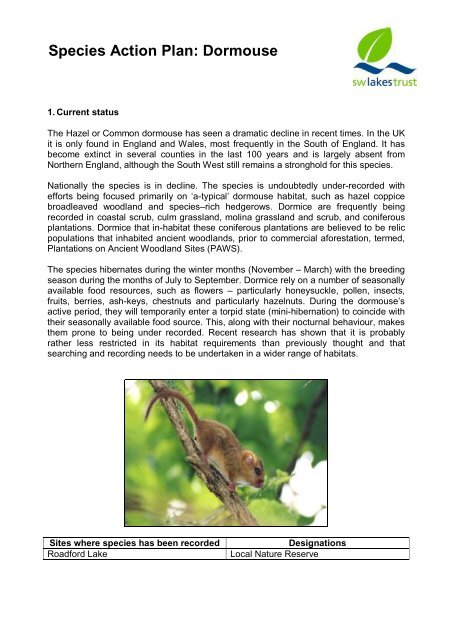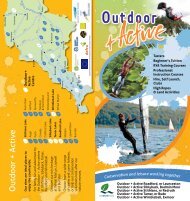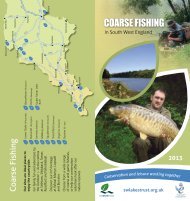dormouse factsheet - South West Lakes Trust
dormouse factsheet - South West Lakes Trust
dormouse factsheet - South West Lakes Trust
Create successful ePaper yourself
Turn your PDF publications into a flip-book with our unique Google optimized e-Paper software.
Species Action Plan: Dormouse1. Current statusThe Hazel or Common <strong>dormouse</strong> has seen a dramatic decline in recent times. In the UKit is only found in England and Wales, most frequently in the <strong>South</strong> of England. It hasbecome extinct in several counties in the last 100 years and is largely absent fromNorthern England, although the <strong>South</strong> <strong>West</strong> still remains a stronghold for this species.Nationally the species is in decline. The species is undoubtedly under-recorded withefforts being focused primarily on ‘a-typical’ <strong>dormouse</strong> habitat, such as hazel coppicebroadleaved woodland and species–rich hedgerows. Dormice are frequently beingrecorded in coastal scrub, culm grassland, molina grassland and scrub, and coniferousplantations. Dormice that in-habitat these coniferous plantations are believed to be relicpopulations that inhabited ancient woodlands, prior to commercial aforestation, termed,Plantations on Ancient Woodland Sites (PAWS).The species hibernates during the winter months (November – March) with the breedingseason during the months of July to September. Dormice rely on a number of seasonallyavailable food resources, such as flowers – particularly honeysuckle, pollen, insects,fruits, berries, ash-keys, chestnuts and particularly hazelnuts. During the <strong>dormouse</strong>’sactive period, they will temporarily enter a torpid state (mini-hibernation) to coincide withtheir seasonally available food source. This, along with their nocturnal behaviour, makesthem prone to being under recorded. Recent research has shown that it is probablyrather less restricted in its habitat requirements than previously thought and thatsearching and recording needs to be undertaken in a wider range of habitats.Sites where species has been recordedRoadford LakeDesignationsLocal Nature Reserve
2. Current factors causing loss or decline• Loss of habitat such as ancient broadleaved woodland, species–richhedgerows, culm grassland and associated scrub and mature woodland ofancient origin.• Unsuitable woodland management and fragmentation of habitat i.e. clearfelling of woodlands, over management and particularly the repeated flailing ofhedgerows.• Loss of habitat connectivity between smaller woodlands via loss ofhedgerows.• Changes or cessation in silviculture practises i.e. planting of coniferwoodlands, coppicing and hedgerow removal.• Loss of habitat to development.• Predation may not be a limiting factor. However, domestic cats can have animpact on localised populations adjacent to urbanised developments.3. Current action3.1 Legal statusDormice are afforded protection under the Wildlife and Countryside Act 1981 and theConservation Regulations under the Habitats Directive (1994). Under this legislation it isan offence to intentionally or recklessly kill, injure or take a <strong>dormouse</strong>. It is also anoffence to intentionally damage, destroy or obstruct access to any place that a<strong>dormouse</strong> uses for shelter or protection (i.e. its habitat). Criminal offence carries a fine ofup to £5,000 per <strong>dormouse</strong> and also carries a custodial sentence of up to six monthsimprisonment.3.2 Site protectionDormice have been recorded in three areas at Roadford Lake. The two fragmentedpopulations exist at <strong>South</strong>week Wood, north of the lake and Slew Wood, south of thesite below the dam. These two fragmented populations are believed to be from a largerpopulation that existed here prior to the flooding of the dam. Records have also beenfound of dormice inhabiting hedgerows alongside a minor road (Gaddacome Lane,Roadford) towards the east of the site. <strong>South</strong>week Wood was designated a Local NatureReserve in 2006 by <strong>West</strong> Devon Borough Council. The site is afforded legal status forthis species and the habitats that it supports. The woodland is of ancient origin (> 50 –100 years) consisting of many mature oaks and hosts an array of ancient woodlandindicators, including wood sorrel and extensive bluebell carpets in the spring.3.3 Species and population protectionThe SWLT <strong>dormouse</strong> monitoring project was initiated in early 2005 and has so faridentified <strong>dormouse</strong> populations within three different areas at Roadford. Over 50<strong>dormouse</strong> boxes have been permanently erected in <strong>South</strong>week Wood revealing ahealthy but fragmented population. However, <strong>dormouse</strong> tubes erected in Slew Woodrevealed the presence of dormice in 2006 and therefore nest boxes were erected,howver since then no records have been made and the boxes were moved toCoombepark Wood in March 2009. Continued monitoring of all the sites is on going.This project is being undertaken in conjunction with the National Dormouse MonitoringProject and the data used to monitor <strong>dormouse</strong> distribution and abundance nationally.
Records are also sent to the National Biodiversity Network (NBDN) and to NaturalEngland’s representative for this species.Woodland restoration projects have been initiated at Roadford and Lopwell Dam LocalNature Reserve for this species. One hundred honeysuckle plants were planted in<strong>South</strong>week Wood, Roadford LNR. Over 300 natively sourced hazel saplings along with50 honeysuckle plants were planted in one hectare of woodland at Lopwell Dam LNR.Extensive sycamore removal was also undertaken over a three-year period at LopwellLNR to encourage this species. Tree felling (volumes) was less than 5m 3 per quarterand was undertaken within the Forestry Authority guidelines. Dormouse nest-tubesurveys revealed the absence of dormice at Porth reservoir, Cornwall in 2005.In 2008 SWLT initiated monitoring at Wimbleball Lake where a nest was discovered andin 2009 nest tubes were erected at College, Trenchford, Lopwell Dam and Burrator.Monitoring will continue throughout 2009 and 2010 at these sites.3.4 Advisory• Ensure that staff and managers are aware of the presence and importance of thisspecies and are advised on appropriate management. This is particularlyimportant in relation to silviculture and forestry operations.• Ensure that contractors undertaking estate work are fully briefed in advance ofthe presence of dormice on site and that operations will not cause any detrimentto the population.Dormouse in nest box4. SWLT objectives and targets• Undertake detailed survey of Roadford Lake to establish other locations andextent of relic <strong>dormouse</strong> population.• Increase the number of nest-boxes at Roadford Lake. Nesting sites are thelimiting factor in <strong>dormouse</strong> population dynamics.• Notify the statutory conservation agencies lead representative for this species onthe location and extent of population.• Ensure the long-term protection of the site along with appropriate management.• Consider notifying or designating sites or area as a SSSI.
• Undertake a desktop study to identify historic sites for this species on all SWLTsites.• Initiate nest-tube surveys at other suitable SWLT sites.• Pursue Agri-environmental schemes offering grants for hedge and hedgebankrestoration.• Pursue Natural England offering grants to support <strong>dormouse</strong> conservationinitiatives across the southwest.5. SWLT action plan for <strong>dormouse</strong>Action Potential Partners Target DatePolicy & Legislation1. Section 13 (Schedule 5) of the Wildlife and Responsibility of Natural EnglandCountryside Act 1981.2. Schedule 2 of the Conservation (Natural Habitats, Responsibility of Natural England&c) Regulations 1994 (Regulation 38).3. The Countryside & Rights of Way Act 2000 Responsibility of Natural England(CRoW).Site Safeguard & Management1. Sites supporting dormice should be identified andOn-goingadvice provided to site managers/rangers onappropriate management2. Pursue Agri-environmental schemes offer grants DefraOn-goingfor hedge and hedge bank restoration.3. Pursue Natural England grants to supportOn-going<strong>dormouse</strong> conservation initiatives.4. Encourage the management of woodlands andOn-goinghedgerows to maintain existent populations andprevent habitat fragmentation.Species Management & Protection1. Continue SWLT nest-box monitoring project atOn-goingRoadford Lake.2. Continue woodland management at RoadfordOn-goingLake for the benefit of dormice. Selective coppicing,hazel ‘layering’ and planting, and the planting ofhoneysuckle at known dormice sites.3. Erect 50 <strong>dormouse</strong> nest-boxes in Slew wood,2007Roadford, monitor and include in NDMP.4. Erect <strong>dormouse</strong> nest-boxes (10 – 15) in2010hedgerows (Gaddacome Lane, Roadford, towardsthe east of the site) and monitor.Advisory1. Nominate Roadford Lake as an example of best2008practise for <strong>dormouse</strong> conservation.2. Produce summary guidance leaflet based on SWW, NE, 2010SWLT monitoring project and NE conservationhandbook on best practise for landmanagers/owners etc.Future Research & Monitoring1. Survey areas for the presence of dormice with the2010aid of dormice nest-tubes on all suitable SWLT sites2. Erect <strong>dormouse</strong> nest-boxes (minimum of 50) on2011sites that have dormice present and include inNDMP.Communications & Publicity1. Ensure public awareness of the species as a key2010indicator of desirable woodland and hedgerowconditions.2. Produce information/articles for the general publicon conservation of the species.2010
7. Links with other action plansThis plan should be considered in conjunction with the following habitat action plans: -• Ancient and/or species-rich hedgerows• Purple moor grass and rush pasture• Upland oak woodland• Lowland beech and yew woodland8. Useful linksUK Biodiversity Action Plan for Common/Hazel Dormouse (Muscardinus avellanarius):http://www.ukbap.org.uk/UKPlans.aspx?ID=462Regional, District, National Park and Local BAPs:http://www.swbiodiversity.org.uk/Home_LBAP.htm<strong>South</strong> <strong>West</strong> Regional Biodiversity Partnership:http://www.swbiodiversity.org.uk/index.htmNational Biodiversity Network for Common/Hazel Dormouse (Muscardinus avellanarius):http://www.searchnbn.net/searchengine/search.jsp?tab=1&pg=1&searchTerm=Hazel%20DormouseNational Dormouse Monitoring Programme: http://www.ptes.org/work/baps/hazel<strong>dormouse</strong>.htmlStatus of Species and Habitat Report for Common/Hazel Dormouse (Muscardinusavellanarius): http://www.ukbap.org.uk/library/Reporting_pdfs/UKListID462_2002.pdf








